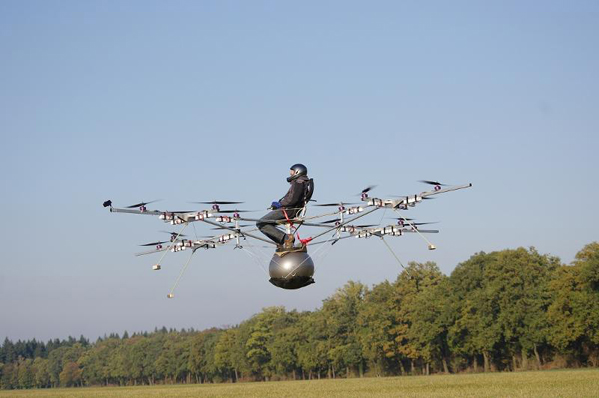Last week at AERO-Friedrichshafen, Erik Lindbergh, grandson of Charles and Anne Morrow Lindbergh,  announced the AERO 2012 winner of the Lindbergh Prize. The Lindbergh Foundation’s aviation prizes are designed to recognize and stimulate innovation, and promote meaningful advancements in green aviation.
announced the AERO 2012 winner of the Lindbergh Prize. The Lindbergh Foundation’s aviation prizes are designed to recognize and stimulate innovation, and promote meaningful advancements in green aviation.
Many innovative aircraft designs on display at AERO-Friedrichshafen this year were considered by the independent judging panel, but one aircraft stood out, e-volo, the winner of the AERO 2012 Lindbergh Prize for Innovation. In fact, this aircraft was so innovative that it appears to be in a category all by itself.
The e-volo Volocopter VC1 is a completely novel vertical take-off and landing (VTOL) system. Using the distributed power of multiple small electric propulsion units, e-volo has demonstrated breakthroughs in redundancy, simplicity of controls and inefficiencies inherent in the control surfaces normally used in aircraft.
Safety: The VC1 proof of concept includes multiple redundancies of all security relevant systems including 16 motors, controllers and propellers. The next phase design, Volocopter VC evolution 2P, will relocate the propulsion units above the fuselage which should improve the stability with a lower center of gravity and allow for the use of a whole airframe parachute (a safety system not normally available in a helicopter).
Simplicity: e-volo has demonstrated control of this aircraft with a fly-by-wire system using a joystick. One can imagine that a new generation of pilots will be able to transition right from their smart phones and game stations to the Volocopter, an aircraft that will ultimately be easy and safe to fly.
Efficiency: The e-volo system has a unique application of electric power to control flight direction and velocity, much different than normal flight controls. For example, ailerons, elevators and rudders create drag when they are applied to change the flight path of a normal aircraft. The VC1 demonstrates the potential of differential power to change flight path which will reduce the amount of power required. Also, with multiple small distributed electric propulsion units the amount of noise generated is significantly reduced.
"We believe that the development of the Volocopter holds significant promise to radically change short distance transportation," said Erik Lindbergh. "It has a long development path ahead, but if this innovative design reaches the commercial market it will dramatically change the way we move about the planet."
The Bose Corporation provided two QC-15 acoustic noise cancelling headsets to be awarded to the prize winning team.



